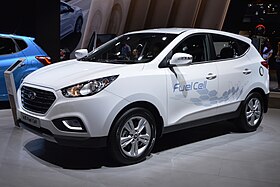| Hyundai ix35 Fuel Cell | |
|---|---|
 Hyundai ix35 Fuel Cell | |
| Overview | |
| Manufacturer | Hyundai |
| Production | 2013–2018 |
| Body and chassis | |
| Related | Hyundai Tucson (LM) |
| Powertrain | |
| Electric motor | Fuel cell hydrogen-powered |
| Range | 594 km (369 mi) |
| Chronology | |
| Successor | Hyundai Nexo |
The Hyundai ix35 FCEV or Tucson FCEV[1] is a hydrogen fuel cell electric vehicle developed by Hyundai. The model is a left-hand drive only conversion to the SUV platform it is based on and was the first of its type to be mass-produced and sold commercially in the world.[2][3] Different versions are known, the previous version was based on the Hyundai Tucson FCEV, and the upcoming model is based on the current ix35 FCEV. The first generation was introduced in 2001, with the Hyundai Santa Fe FCEV, and had a range of 100 miles (160 km), with a top speed of 78 mph (126 km/h).
The second generation Tucson FCEV was introduced in 2005, used a graphite bipolar plate and had a range of 186 miles (300 km), with a top speed of 93 mph (150 km/h). The third generation is based on the Hyundai ix35 (2009), production was semi automatic and used a metal bipolar plate.[4]
The current version and fourth generation is the 2012 ix35 FCEV. The Tucson ix35 FCEV has a more powerful electric engine rated at 100 kW (134 horsepower), and a range of about 369 miles (594 km). This improvement in range is due in part to the Tucson ix35 FCEV's greater space for holding Hydrogen tanks of compressed hydrogen, higher storage pressure, as well as fuel cell technology advances.
The cars have made use of a "sandwich" design concept, aimed at maximizing room for both passengers and the propulsion components. The fuel cell is a proton exchange membrane fuel cell (PEMFC).
- ^ Hyundai aims to sell 10,000 FCEVs in South Korea by 2025
- ^ "The World’s First Mass-Production of FCEV", accessed November 18, 2018
- ^ "Hyundai ix35 Fuel Cell", accessed November 18, 2018
- ^ "Hyundai fcev deployment" (PDF). Archived from the original (PDF) on 2015-12-11. Retrieved 2014-11-30.